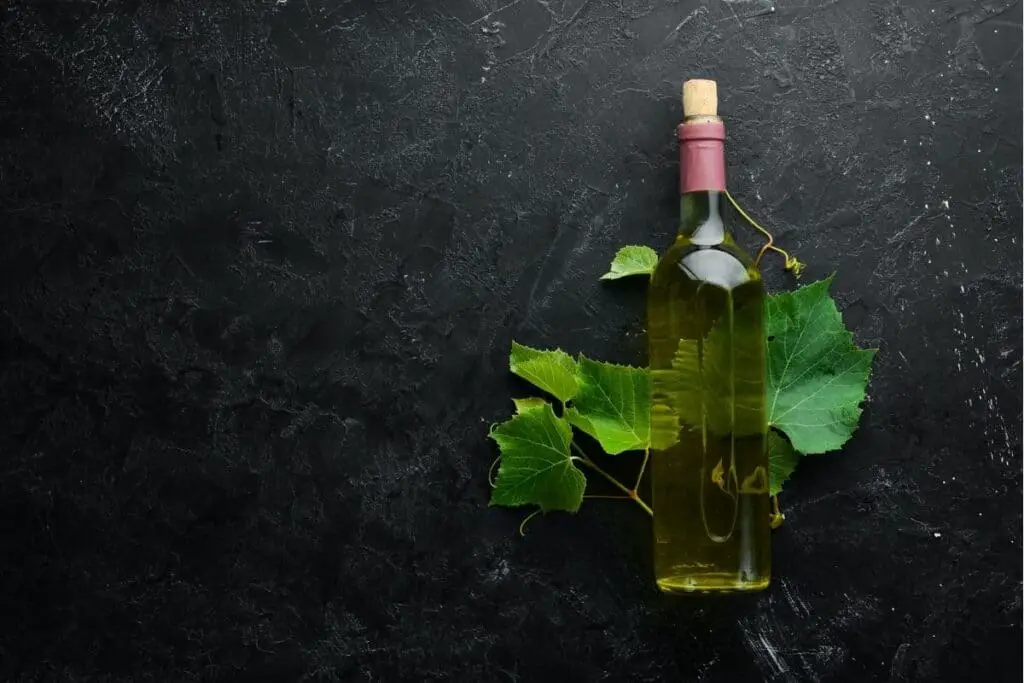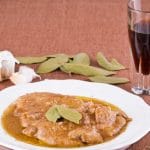In a nutshell, the best alternatives to white wine for cooking in recipes include vermouth, white grape juice, white wine vinegar, apple cider vinegar, etc… I will explain how to use and how much to use below.
Wine is not only delicious for drinking but has a lot to offer in cooking. If there’s leftover wine that’s too good to waste in the fridge, a great way to use it is by cooking with it. Depending on the dish you are making, it will play a different role in the blend of ingredients. In cream-based dishes, it cuts the richness and adds depth, while in other dishes, it can add a fruity, acidic note.
If your recipe calls for white wine and you’re all out, or you need an alcohol-free alternative, there are convenient replacements for white wine in cooking you can use instead.
In this guide, we’ll recommend the best dry white wine substitutes, and the chances are good that you already have some of these options in the pantry.
How to Choose a White Wine Substitute
It is beneficial to know what role wine plays in your dish when choosing a substitute. Some substitutes add acidity, while others bring sweetness. Consider this as an important factor when choosing the best alternative to white wine in cooking so it can bring similar properties to the dish.
In addition, there are both alcoholic and non-alcoholic substitutes you can use. When cooking for someone who needs to avoid alcohol for health or religious reasons, make sure to use a non-alcoholic alternative. When using an alcoholic substitute, remember to give enough cooking time for the alcohol to burn off.
What Can I Substitute for White Wine in Cooking?
1. Vermouth
This is a fortified wine and the only alcoholic substitute on our list. Like white wine, vermouth comes in dry and sweet varieties. The main difference is, however, that it is infused with botanical flavors, herbs, and spices, some types are sweetened, and it has a higher alcohol content than wine.
With 15 to 18% alcohol by volume, vermouth is most suitable as a replacement in recipes that require ¼ cup or less wine to prevent the alcohol taste from being overwhelming. Replace it in equal quantities.
Use vermouth if your recipe calls for white wine or dry white wine, and keep the sweet version for desserts only as it will overpower the flavor profile of your dish.
Top tip: Once added to your sauce or stew, it has to cook for at least 15 to 20 minutes for 50 to 60% of the alcohol to burn off. The longer the cooking time, the more alcohol will evaporate, leaving only the flavor-enhancing quality.
2. White Grape Juice
It probably doesn’t come as a surprise that white grape juice is on the list of substitutes for white wine. The unfermented form of white wine is similar in color and made from the same fruit; however, it is much sweeter in taste. That means you’ll need to add some acidity and dilute the juice to prevent turning your savory dish into a dessert. If you need a replacement for dessert, add a squeeze of lemon juice as well to balance out the excessive sweetness.
If your recipe calls for half a cup of dry white, replace it with ¼ cup white grape juice mixed with ¼ cup water to dilute it. To balance the sweetness, add one teaspoon of vinegar or lemon juice.
3. White Wine Vinegar
Ferment and oxidize white wine into acid, and you’ll get white wine vinegar. It has a fruity flavor and is ideal for pan sauces and vinaigrettes. Note that this is not the same as white vinegar and the two types of vinegar are not interchangeable. White vinegar is made from grain alcohol and has a sharp, sour flavor.
Due to its acidic intensity, even with its fruity notes, the amount of vinegar used as a replacement will always be less or needs to be diluted. If your recipe requires just a little wine for deglazing a pan, add only half a teaspoon of white wine vinegar.
If your recipe requires any more, it is best to dilute the vinegar with broth. This will balance out the intensity but still offer slight acidity and complex fruity undernotes. To replace half a cup of wine, dilute two tablespoons of vinegar in broth equal to half a cup, so the liquid quantity stays the same. If you find that there is not enough acid tang towards the end of the cook, add a squeeze of lemon.
Related: What can I substitute for white wine vinegar?
4. Apple Cider Vinegar
Apple cider vinegar is slightly less intense in acidity than other types of vinegar and has a lovely sweetness. Some people recommend substituting it in an equal amount. However, depending on the dish you are making, you may want to err on the side of caution and start with a diluted solution. If your recipe calls for half a cup of wine, start with a ¼ cup of apple cider vinegar and ¼ cup of water. If you feel the dish lacks acidity, add a little more to taste during cooking.
5. Apple Juice
As with grape juice, apple juice offers a lot of sweetness and little acidity. It is best used for lighter dishes and desserts as opposed to savory or salty recipes. If you are making a fish dish, rather opt for another alternative. To make up for the lacking acidity, add a touch of lemon juice or vinegar.
6. Chicken Broth
Although it doesn’t offer the same sweet, fruity notes nor the acidity, chicken broth will add flavor complexity and even out the liquid ration your recipe requires. This is suitable only for savory dishes. Replace it in equal quantities and add a tablespoon of lemon juice for every half cup of chicken broth to give it the acidic note it is missing.
7. Vegetable Stock
The vegetable stock has very similar properties to chicken broth and brings savoriness rather than sweetness or acidity. It is versatile to use for soups, sauces, stews, and pairs well with any savory flavors whether you are making chicken, fish, pork, vegetarian, or pasta dishes.
Replace it in equal quantities and amp up the flavor and acidity by adding one tablespoon of apple cider vinegar or white wine vinegar per one cup of stock.
8. Ginger Ale
This is another great option for sweet dishes and desserts. It can even go well with pork when balanced with enough acidity and savory notes. It offers a little dryness, a little spicy tang, and similar fruity undertones, but with a lot more sweetness.
For dessert recipes, you can substitute them in equal amounts. If you’re using it with pork, dilute it by half with chicken or vegetable stock and add a tablespoon of lemon juice. If you don’t have stock on hand, diluting it with water will also do the trick.
9. Lemon Juice
Lemon juice is used in a multitude of recipes for various purposes. Its sour tang enhances flavors, and its high acidity can assist in tenderizing meat in marinades.
Lemon juice has the same acidic notes and fruity undertone that you’ll require; however, it is a lot stronger than wine, so it needs to be diluted with water in equal parts when used as a substitute.
Wine Substitution Tips
In our list of substitutes, the only ingredient that can be used as a straight match is vermouth (dry vermouth specifically for savory dishes), as it won’t overpower your dish with either acidity or sweetness but still offers loads of flavor-enhancing characteristics and similar undertones.
Other substitute options require a little thought about the pronounced flavors in your dish and what will complement them best. They may require some adjustment to taste during the cooking process or a few drops of acidity to enhance the flavor match. However, this allows you to tailor the flavors exactly to the way you like them. Experiment, taste, and adjust.
If you are unsure whether the substitute will bring too much acidity or sweetness to your dish, start with a smaller amount first rather than adding too much and changing the flavor profile completely. You can always add more punch, but you can’t always fix something too overpowering.
Cooking With Wine
Whether for a pot of mussels, marinade, dessert, or pasta sauce, wine’s flavor-enhancing properties shine mainly once the alcohol has been cooked off. Wine is usually added at the start of cooking, so the alcohol has enough time to cook. If added towards the end, the raw wine taste will overtake other seasonings in the dish with an unpleasant tangy flavor.
While heat evaporates some of the alcohol, it also destroys some of the more subtle nuances of the vintage and concentrates the acidic wine taste. Different white wines are more suited to different dishes. Dry whites, such as sauvignon blanc, are generally better paired with savory cooking, while sweet white wine is delicious when paired with dessert.
FAQs
The beef broth will be a suitable substitute for red wine with its dark color and deeper flavor. It is best to stick to chicken or vegetable stock when replacing white wine.
The best option is a chicken broth with a few drops of lemon or lime juice. Do not use vinegar when making risotto.
Sake is somewhat stronger and can slightly change the flavor profiles in your recipe, but it’s not a bad choice for steaming shellfish, curing fish, or using it in marinades.
Yes, you can use water as a substitute for white wine in some recipes, but keep in mind that the flavor profile of the dish may change as wine adds acidity and complexity. For the best results, consider using chicken or vegetable broth mixed with a splash of lemon juice as a closer substitute if you don’t have white wine on hand.
Conclusion
White wine is a perfect combination of fruity and acidic flavors. It can also bring a slight touch of sweetness to your cooking. When choosing your substitute, remember that a little goes a long way with strongly acidic ingredients. Always opt for fruity kinds of vinegar and pair them in small amounts with complimenting flavors such as fruit juice, stock, or vegetable broth. Whether you need a non-alcoholic, sweet, or savory substitute, there’s a suitable option for every occasion.
*image by yarunivphoto/depositphotos









